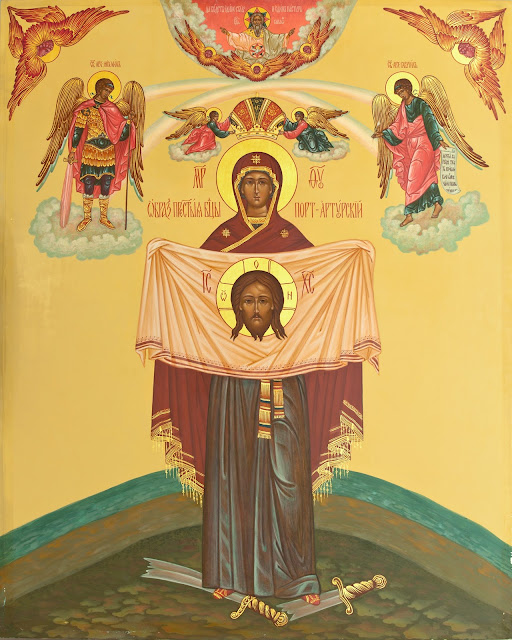Port Arthur icon of the Mother of God, alternatively
known as The Triumph of Theotokos, is the only known image of the Most Pure
Virgin where She holds a cloth with the Image of Christ Not-Made-By-Hands in
Her hands.
This icon is also unique because it was the first
image of the Most Holy Theotokos to be revealed to Christians in the 20th
century. A sailor named Theodore Katansky who visited Kiev Caves Lavra in 1903
told other believers about it. He had been a hero of the defense of Sevastopol
during the Crimean War.
The old sailor related that he had seen the Mother of
God with an image of Christ Not-Made-By-Hands in a dream after praying for
Russian sailors who served in the Far East.
The Blessed Virgin appeared to him surrounded by
Angels and saints. Our Lady comforted the sailor and told him that Russia was
soon to enter into a devastating and difficult war, full of losses and
troubles, along its coastal borders. That was why She ordered to have Her icon
painted and sent to Port Arthur. Brought to the walls of the distant city and
naval base, the holy image was meant to help the Orthodox triumph over the
pagans and inspire Russian soldiers and sailors to fight bravely.
The icon was painted for free by P.F. Stronde, a
painter from Kiev, in 1904, using materials purchased for donated money and
following the old sailor’s instructions. There was an inscription around the
image, which read, “Blessings and wishes of victory to the Christ-loving army
of the Far Russia from holy monasteries of Kiev, 10 000 believers and friends.”
The icon was sent to Saint Petersburg. Unfortunately,
military officials in the capital slowed down its delivery to the fortress. The
image arrived in the Far East when Port Arthur had already been blocked by the
Japanese. After a short stay in Vladivostok, it was sent to General
Kuropatkin’s headquarters. Due to the hasty retreat, Port Arthur icon and
several other holy objects were lost.
The image was miraculously re-discovered in 1998. It
was bought by a group of Russian pilgrims in an antiques shop in Jerusalem on
Via Dolorosa. It remains unclear how and when it got there. The wonder-working
icon returned to Vladivostok after restoration. It stays in the Cathedral in
honor of Holy Protection of the Mother of God in this Russian city.
Translated by The Catalog of Good Deeds
Source: https://pravoslavie.fm/articles/5-interesnyih-obrazov-presvyatoy-bogoroditsyi/
















CONVERSATION